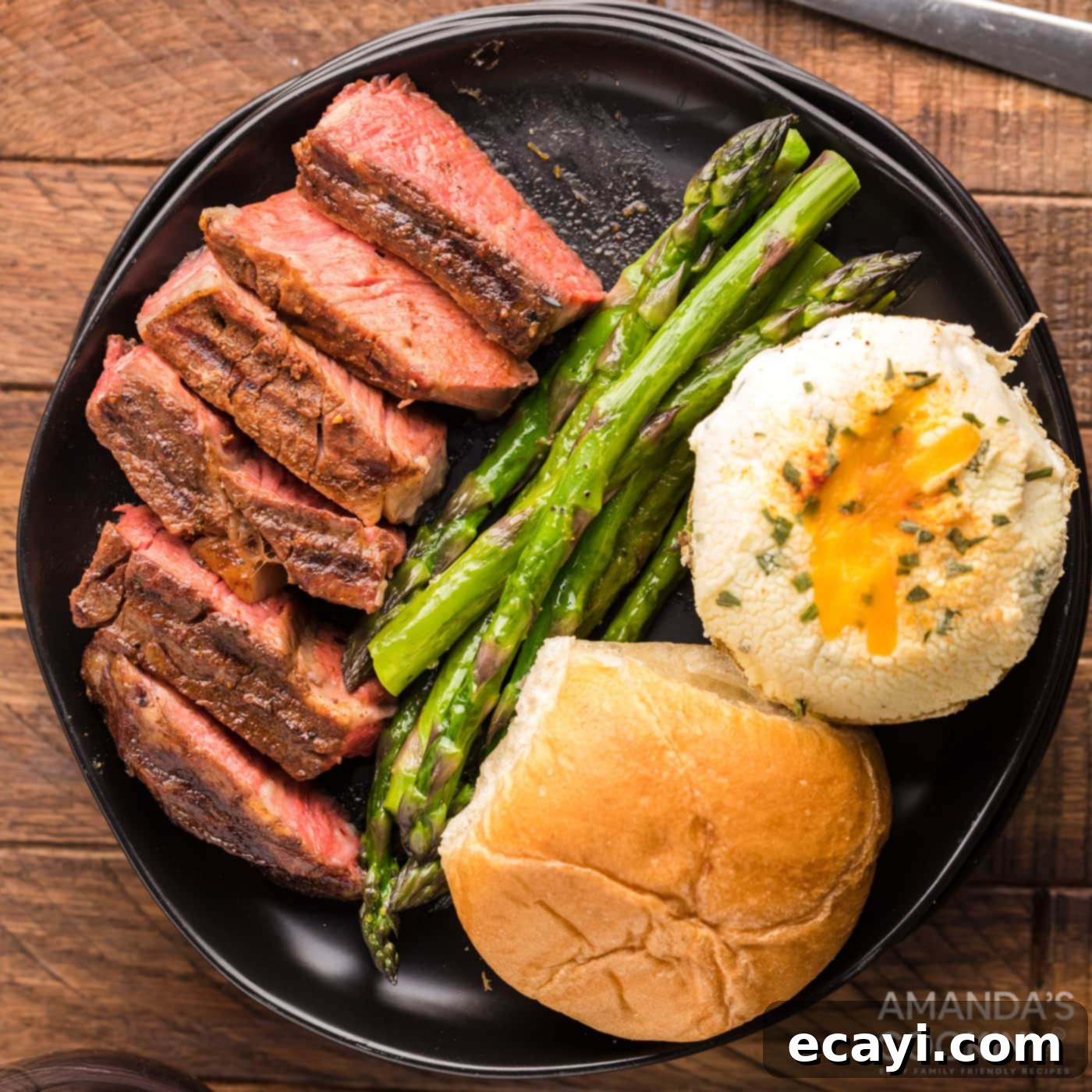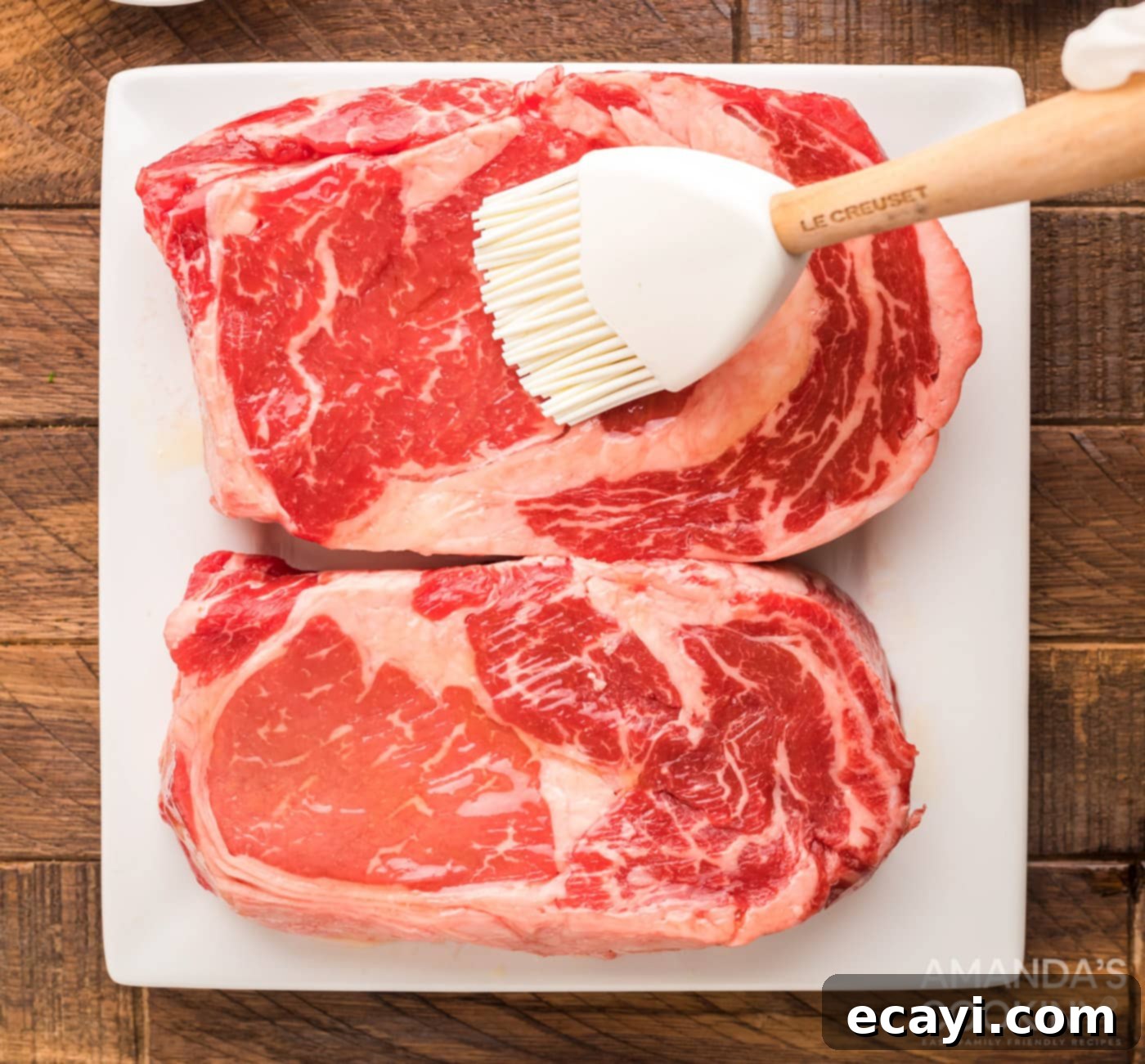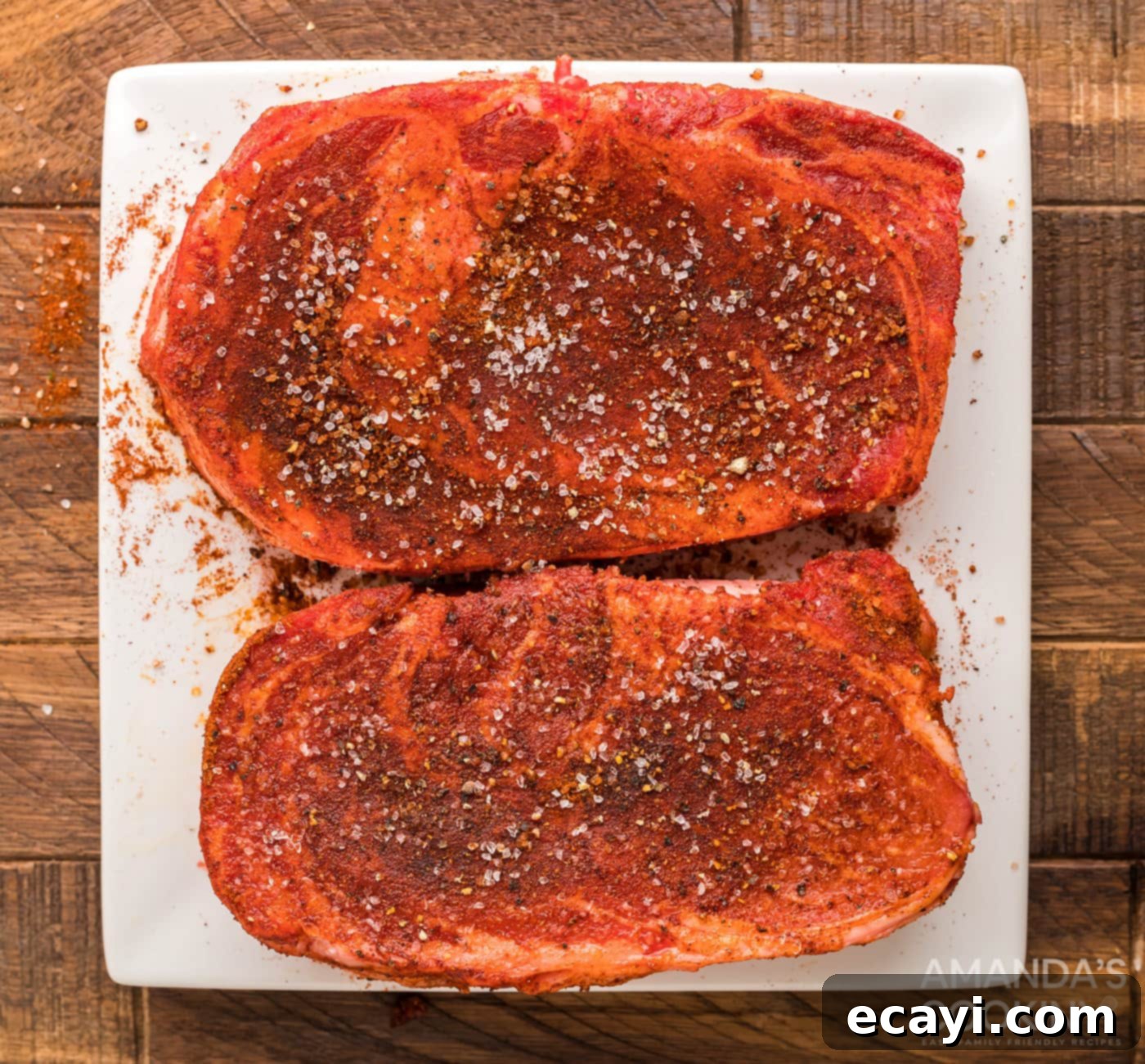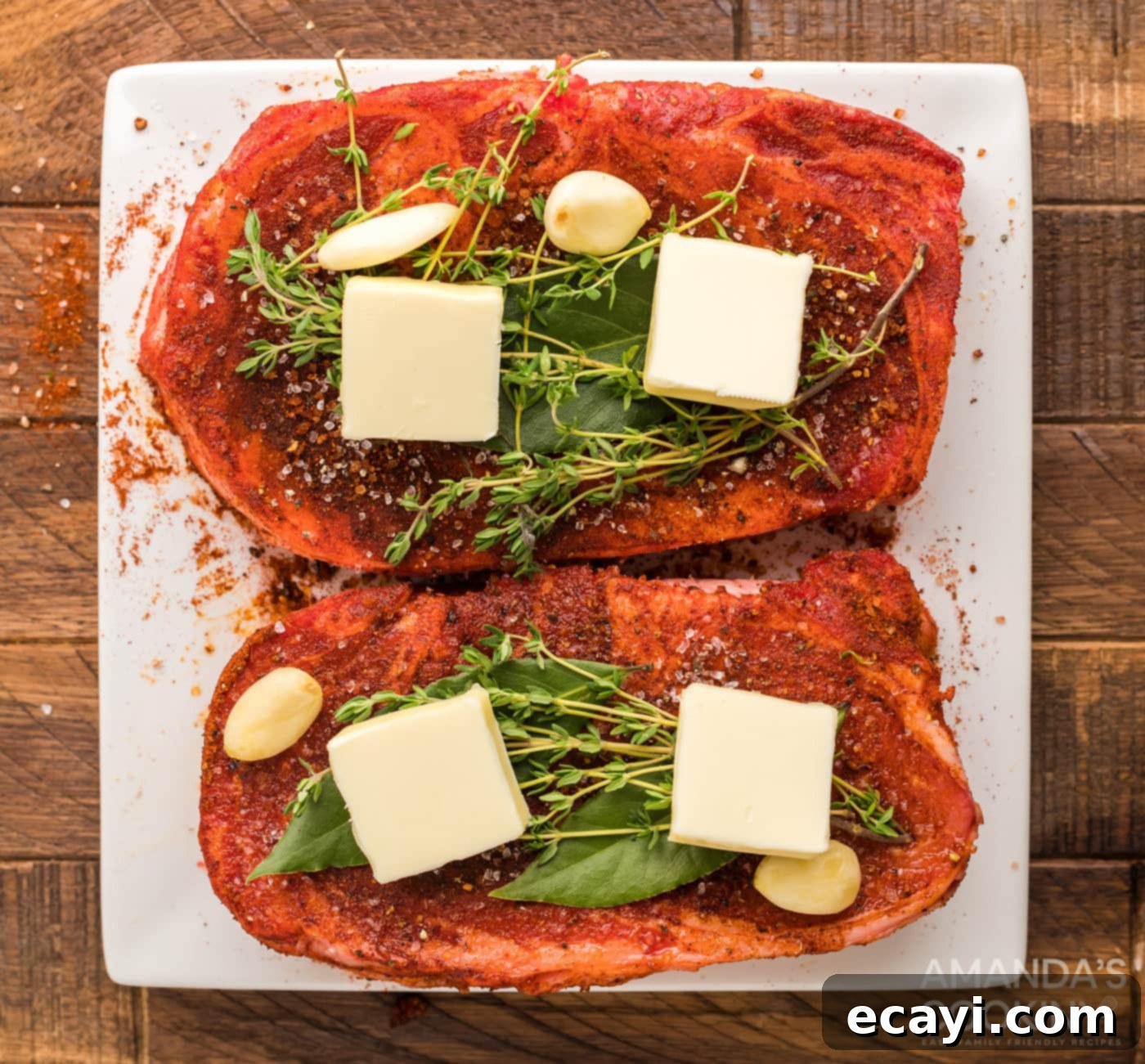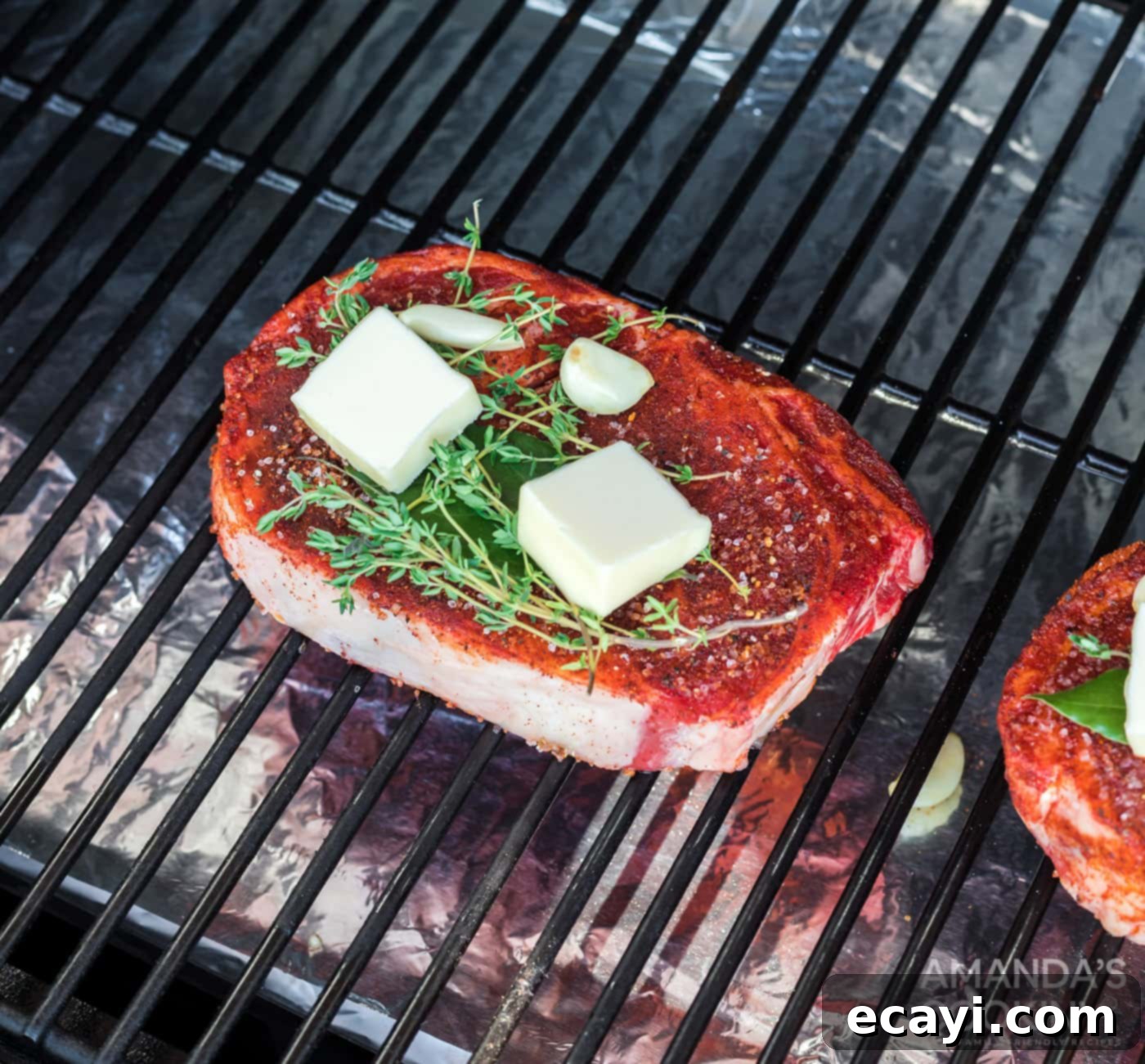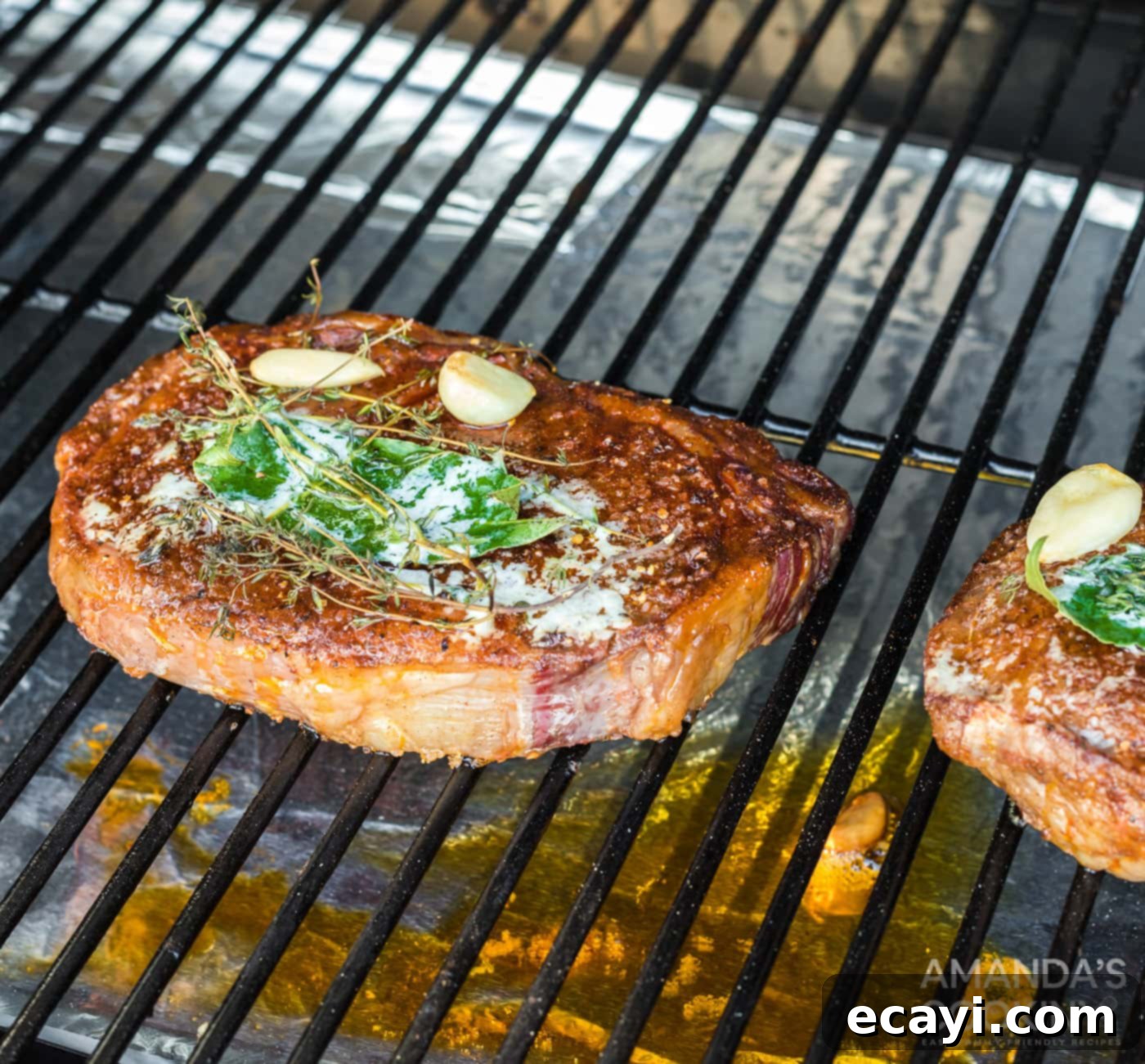Perfectly Smoked Ribeye Steak: The Ultimate Reverse Sear Recipe for Unforgettable Flavor and Tenderness
Discover the secret to restaurant-quality steak right in your backyard with this straightforward method for reverse searing smoked ribeye. This technique yields an incredibly tender, juicy steak with a beautifully light crust, bursting with complex smoky and rich beefy flavors. Prepare for the most satisfying bite you’ve ever experienced.
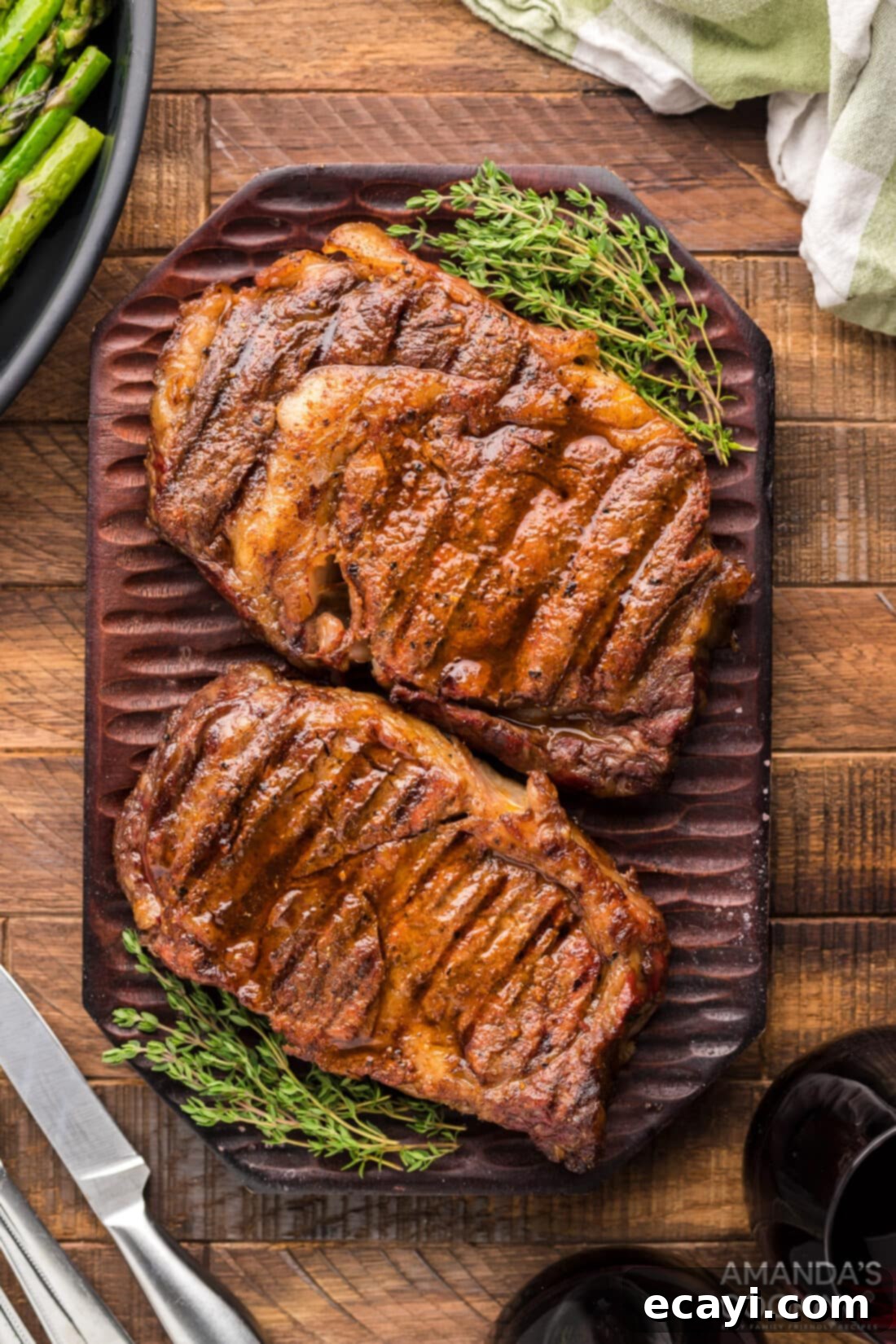
Why This Smoked Reverse Sear Ribeye Recipe Is a Game-Changer
While there are many excellent ways to cook a ribeye—from traditional grilling to pan-searing or even oven-baking—the reverse searing method, especially when paired with slow smoking, elevates this cut of meat to an unparalleled level. If you’ve ever yearned for a steak that’s consistently tender from edge to edge, incredibly juicy, and infused with a deep, aromatic smokiness, then this technique is for you.
Reverse searing simply means cooking your steak gently to near-completion before finishing it with a quick, high-heat sear. This innovative approach stands in contrast to the traditional method of searing first and then slow-roasting. The magic of reverse searing lies in its ability to slowly and evenly bring the internal temperature of the steak up, ensuring uniform doneness throughout the entire cut. This gradual cooking process minimizes the gray band typically seen in traditionally seared steaks, resulting in a perfectly pink interior.
When you combine this method with smoking, you introduce another layer of complexity. The low and slow smoke bath tenderizes the meat further and imparts an irresistible, deep, earthy flavor that penetrates every fiber. The final high-heat sear then creates that desirable, flavorful crust (the Maillard reaction at its best) without overcooking the perfectly tender interior. The result is a ribeye that is not only tender and juicy but also boasts a profound smoky depth that simply cannot be achieved through other cooking methods. This combination locks in moisture and maximizes flavor, making it a truly unbeatable way to enjoy a premium cut like ribeye.
Related Recipe: For another fantastic steak experience, try our classic Reverse Sear Ribeye without the smoke.
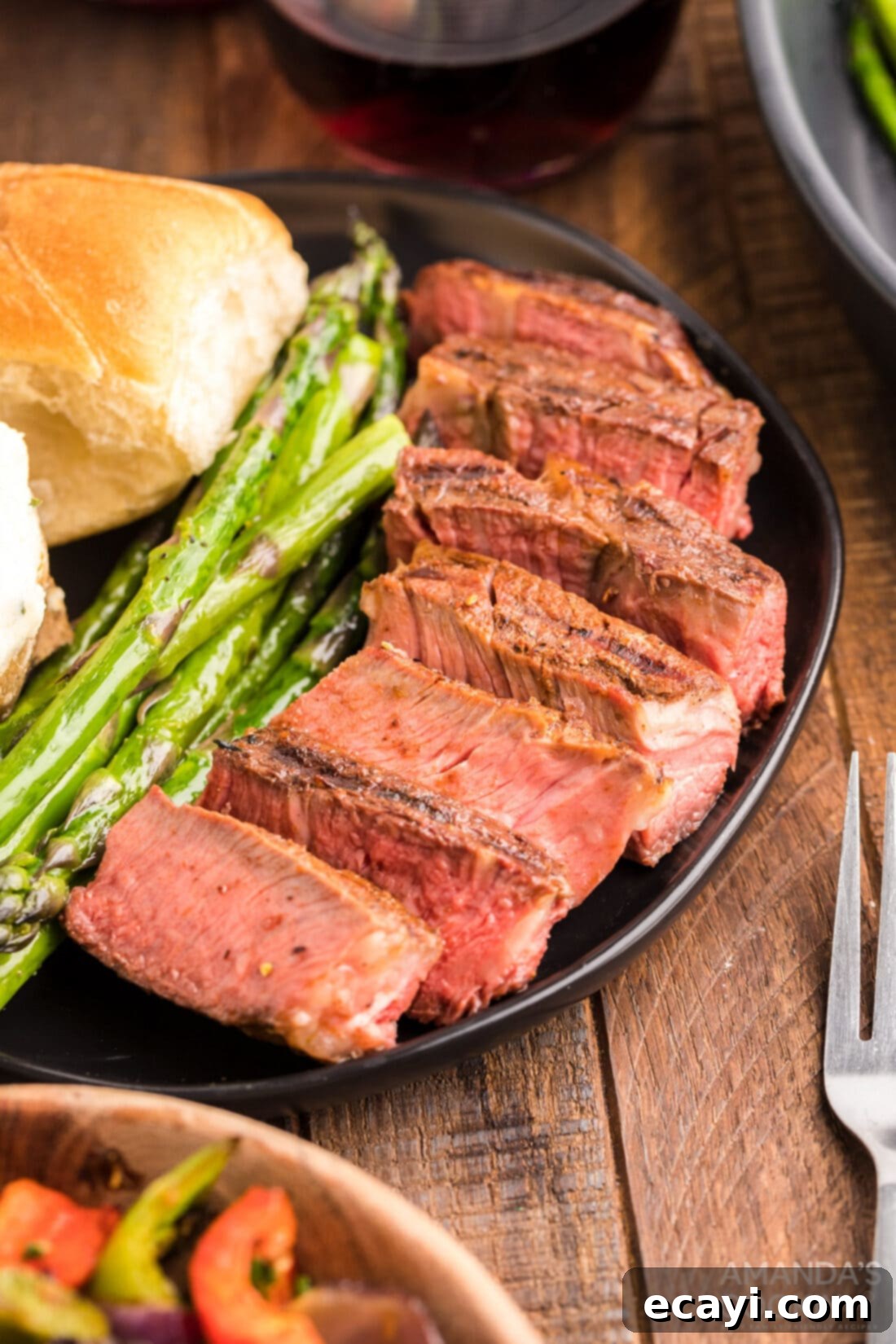
Essential Ingredients for Your Smoked Ribeye
Before you begin, gather all your ingredients to ensure a smooth and enjoyable cooking process. You’ll find a complete list with exact measurements in the printable recipe card at the bottom of this post.
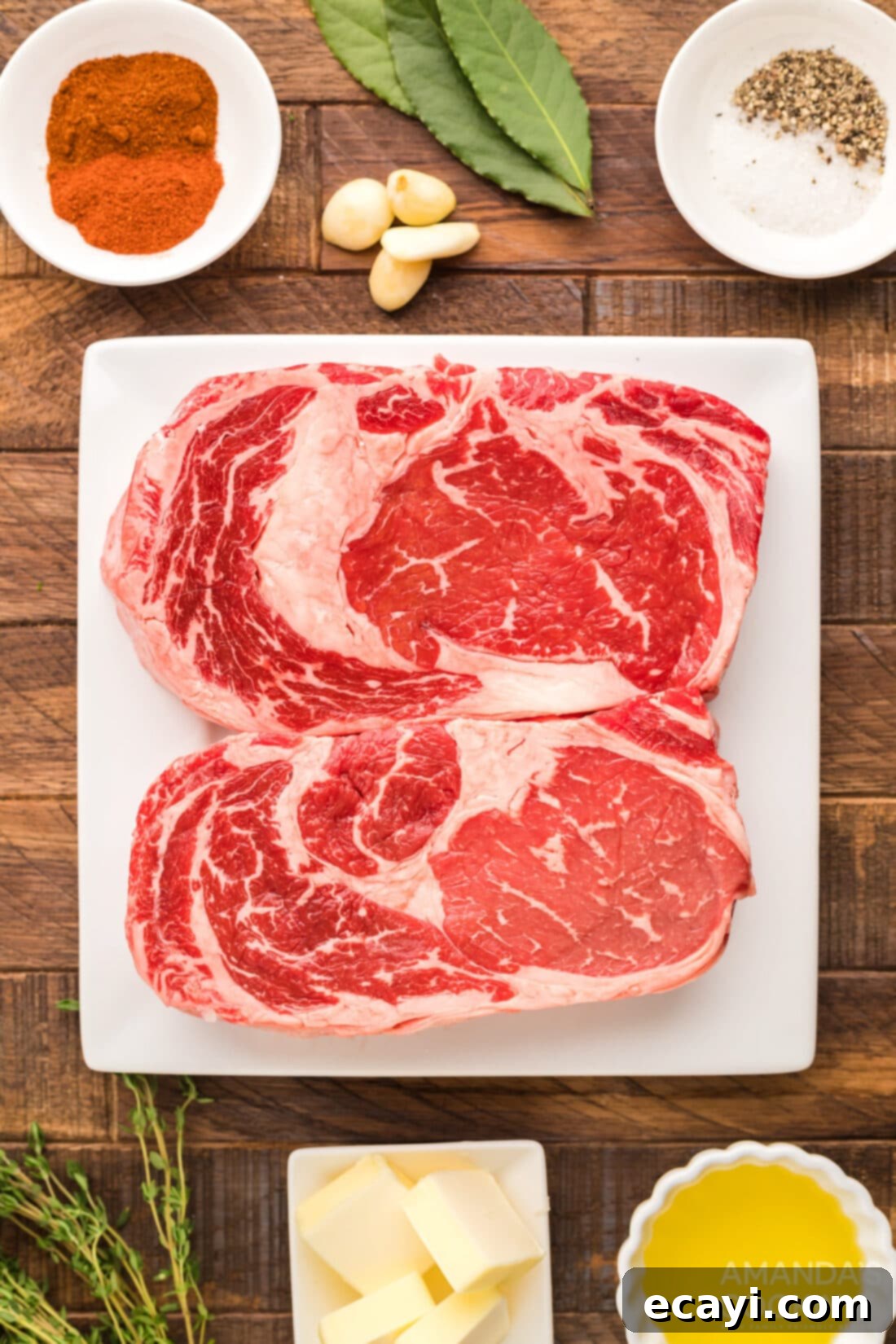
Ingredient Spotlight: Tips for Best Results and Substitutions
THE STEAK: This recipe specifically calls for ribeye, and for good reason. Ribeye is renowned for its generous marbling – those fine streaks of fat interspersed throughout the lean meat. This marbling is key to an intensely flavorful and incredibly tender steak as it melts during cooking, basting the meat from within. When selecting your ribeye, aim for a cut that is at least 1 ½ inches thick. Thicker steaks are more forgiving and allow for a better temperature gradient during the reverse sear, making it easier to achieve that perfect medium-rare center. Look for good marbling across the entire steak, as this will significantly enhance the overall taste and juiciness. While 1 ½ inches is ideal, minor variations in thickness may slightly alter cooking times. For a medium-rare finish, target an internal temperature of 130-135°F. For a medium steak, aim for 135-145°F.
THE SEASONING: Our robust seasoning blend features chili powder, paprika, sea salt flakes, and cracked peppercorn, complemented by salted butter, fresh thyme, bay leaves, and garlic cloves. This combination creates a rich, aromatic crust and infuses the steak with deep flavor. The chili powder and paprika add warmth, color, and a subtle smoky note even before the meat hits the smoker. Sea salt is crucial for drawing out moisture, then reabsorbing it to tenderize the meat. Cracked peppercorn adds a delightful bite. The butter, thyme, and garlic applied during the smoking process melt into the steak, providing an herbal, aromatic basting. If you prefer to let the natural flavor of the high-quality ribeye shine through, a simple yet generous application of just salt and pepper is perfectly acceptable. The choice of seasoning ultimately boils down to personal preference, but this blend offers a wonderfully complex profile. Feel free to experiment with other preferred steak rubs or herbs like rosemary.
Step-by-Step Guide: How to Make Smoked Ribeye with a Reverse Sear
These step-by-step photos and detailed instructions are provided to help you visualize each stage of this delicious recipe. For a complete printable version, including all measurements and a concise instruction list, please jump to the recipe card at the bottom of this post.
- Prepare Your Smoker: Begin by setting up your smoker for success. For easier cleanup, lay a sheet of foil directly under the grill grates. This will catch any drips or fallen pellets. Fill your hopper about ¼ full with mesquite pellets. Mesquite offers a strong, bold smoky flavor that pairs exceptionally well with rich cuts like ribeye, but you can experiment with other woods like hickory, apple, or cherry for different flavor profiles. (We typically use a Traeger smoker for consistent results).
- Season the Ribeyes: Place your boneless ribeyes on a clean plate or cutting board. Drizzle both sides of each ribeye generously with extra virgin olive oil. This acts as a binder for the seasonings and helps create a beautiful crust during searing.

- Apply Seasoning and Rest: In a small bowl, combine your chili powder, paprika, sea salt flakes, and cracked peppercorn. Liberally apply this spice blend to both sides of each ribeye. Take your time to really rub the seasoning into the meat; this ensures it adheres well and creates a robust flavor crust. Don’t forget the edges! Dip the sides of the steak into any leftover seasoning on the board. Once seasoned, let the steaks rest at room temperature for at least 15 minutes while your smoker preheats.
EXPERT TIP: This resting period allows the salt in the seasoning to work its magic. Initially, the salt draws moisture out of the steak, creating a flavorful brine. As the steak rests, this brine is reabsorbed back into the meat, carrying the dissolved seasonings with it. This process not only deeply flavors the steak but also breaks down muscle fibers, resulting in an incredibly juicy and tender final product.

- Preheat the Smoker (First Stage): Close the lid of your smoker and preheat it to 225°F (107°C) for 15 minutes. Achieving a stable low temperature is crucial for the initial smoking phase, which tenderizes the meat and infuses it with smoky flavor without overcooking.
- Prepare Aromatics: While the smoker heats, cut cold salted butter into tablespoon-sized pats. Top each ribeye with 2-3 sprigs of fresh thyme, 2 bay leaves, 2 whole garlic cloves (lightly crushed if you prefer more garlic flavor), and 2 tablespoons of the cold butter. These aromatics will gently melt and infuse the steak with their flavors during the low-temperature smoke.

- Smoke the Ribeyes: Carefully place the prepared ribeyes directly onto the center of the grill grates in your preheated smoker. Smoke for approximately 45 minutes, or until the internal temperature of the steak reaches 120°F (49°C) when measured with an instant-read thermometer. This initial low-temperature smoke ensures deep flavor penetration and gentle cooking.

- Rest and Increase Smoker Temperature: Once the steaks reach 120°F, remove them from the smoker and discard the used thyme, bay leaves, and garlic cloves (unless you plan to save the smoked garlic for a delicious smoked aioli or butter). Place the steaks on a clean cutting board or plate and let them rest while you prepare for the sear. Immediately increase your smoker’s temperature to 450°F (232°C) and allow it to come to full temperature, which usually takes about 10 minutes. This resting period for the steak, even before the final sear, helps redistribute juices.

- Sear for the Perfect Crust: Once your smoker reaches 450°F, place the rested ribeyes back onto the hot grill grates. Sear for exactly 1 minute per side. This quick, high-heat sear is crucial for developing that beautiful, crispy, and flavorful crust through the Maillard reaction. For a medium-rare steak, 1 minute per side is typically sufficient. If you prefer a medium doneness, add an additional minute per side.
EXPERT TIP: Remember that your steak will continue to cook internally even after it’s removed from the heat (this is known as carryover cooking). During the final resting period, the internal temperature will typically rise by about 5°F. Therefore, remove your steak from the heat slightly before it reaches your desired final temperature. Factors like steak size and thickness can slightly influence cooking times, so always rely on your instant-read thermometer.
- Final Rest, Slice, and Serve: Remove the seared ribeyes from the heat and let them rest for a crucial 10 minutes. This final rest allows the juices, which have migrated to the center during searing, to redistribute evenly throughout the steak, ensuring every bite is succulent and tender. After resting, slice the ribeye against the grain into desired portions. Serving against the grain shortens the muscle fibers, making the steak even more tender to chew. Enjoy this masterpiece with your favorite vegetables and sides!
Frequently Asked Questions & Expert Tips for Smoked Ribeye
For a perfectly medium-rare smoked ribeye steak, the target internal temperature should be between 130-135°F (54-57°C) after resting. If you prefer a medium doneness, aim for 135-145°F (57-63°C). Always use a reliable instant-read meat thermometer to ensure accuracy and achieve your desired results.
If your smoker struggles to reach the high temperatures required for searing (450°F/232°C), don’t worry! You have excellent alternatives. After smoking the ribeye to 120°F and letting it rest, you can sear it on a very hot cast iron pan over your stove. Preheat the pan until it’s smoking hot with a tiny bit of high smoke point oil (like avocado or grapeseed oil). Sear for 1-2 minutes per side until a beautiful crust forms. Alternatively, an indoor or outdoor gas grill can also be used for the final sear, ensuring it’s preheated to its highest setting.
Mesquite pellets provide a strong, distinctive smoky flavor that stands up well to ribeye’s richness. However, you can also use hickory for a robust, bacon-like smoke, or fruit woods like apple or cherry for a milder, sweeter flavor profile. Oak is another excellent choice, offering a medium-strong, classic BBQ smoke. The choice depends on your personal preference and what complements your chosen seasoning blend best.
While ribeye is exceptional for this method due to its marbling and thickness, you can certainly adapt the reverse sear and smoke technique to other thick cuts. New York strip, porterhouse, or even a thick top sirloin can work well. Adjust smoking and searing times based on the steak’s thickness and your desired internal temperature. Just remember that cuts with less marbling may not be quite as tender or juicy as a ribeye.
To store leftover smoked ribeye, allow it to cool completely, then wrap it tightly in plastic wrap or aluminum foil, or place it in an airtight container. It can be refrigerated for 3-4 days. For reheating, gently warm slices in a pan over low heat, or use a conventional oven at a low temperature (around 250°F/120°C) until just warm to avoid drying out the meat. You can also enjoy it cold, sliced thinly, in sandwiches or salads.
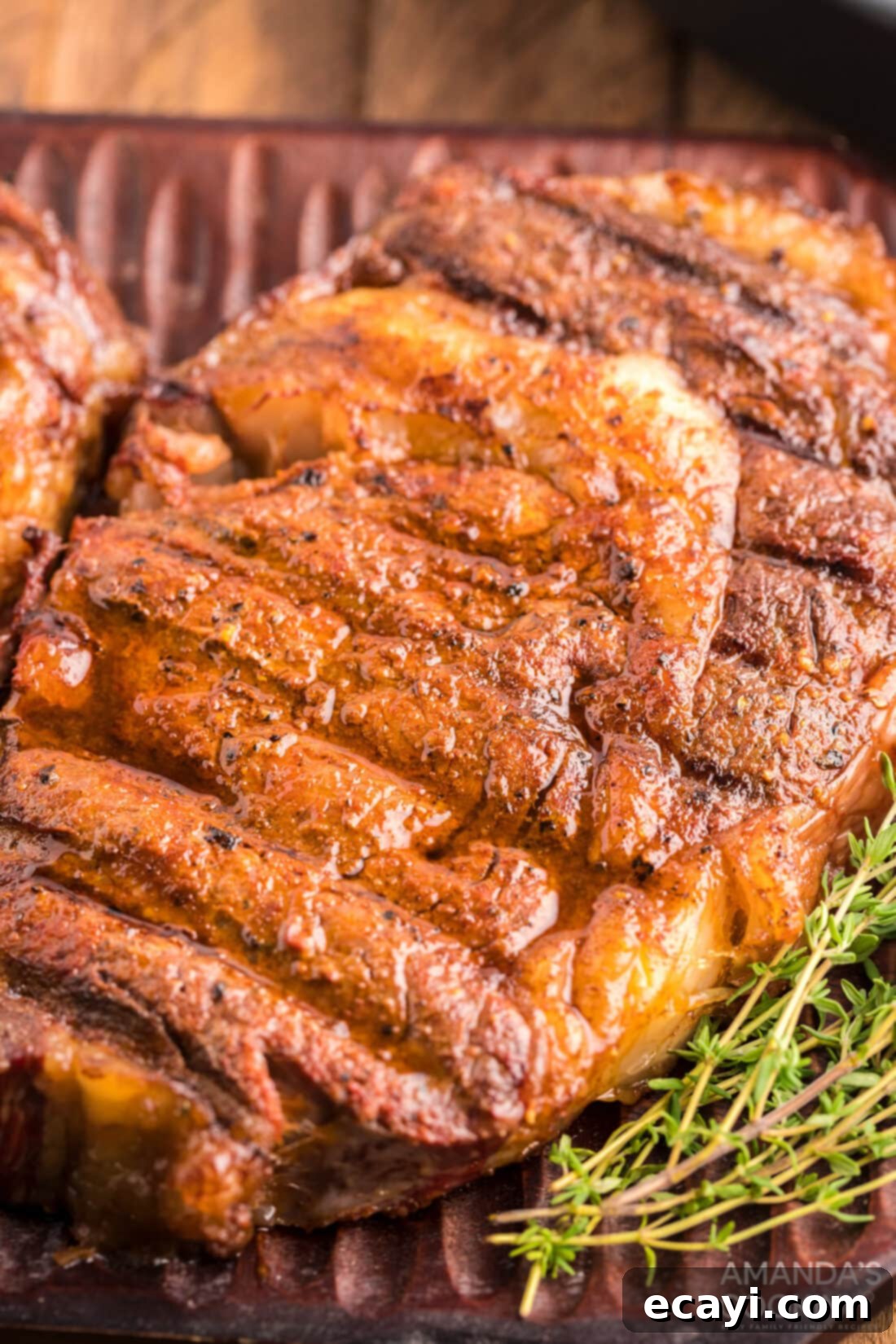
Delicious Serving Suggestions for Your Smoked Ribeye
A beautifully cooked smoked ribeye steak pairs wonderfully with a variety of side dishes, enhancing the overall dining experience. Here are some of our favorite recommendations to complement the rich, smoky flavors of your steak:
- Cheesy Bacon Chive Twice Baked Potatoes: The creamy, cheesy goodness of these potatoes offers a comforting contrast to the savory steak.
- Grilled Asparagus: Lightly grilled asparagus provides a fresh, slightly bitter counterpoint that cleanses the palate and complements the richness of the meat.
- Grilled Corn on the Cob: Sweet and smoky grilled corn adds a delightful crunch and a hint of summer flavor that harmonizes with the ribeye.
- Homemade Pull-Apart Dinner Rolls: Soft, warm dinner rolls are perfect for soaking up any delicious juices left on your plate.
- Baked Sweet Potato Fries: The subtle sweetness and crispy texture of sweet potato fries offer a delicious alternative to traditional potatoes.
- Grilled Corn and Zucchini Salad with Feta: A vibrant, fresh salad with grilled vegetables and tangy feta provides a refreshing balance to the hearty steak.
I absolutely adore sharing my culinary adventures and kitchen wisdom with all of you! To make sure you never miss a new recipe, I offer a convenient newsletter delivered right to your inbox. Simply subscribe here and start receiving your free daily recipes, designed to inspire your next meal!
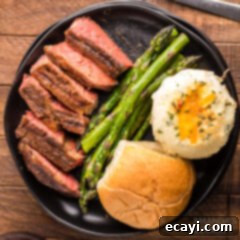
Smoked Ribeye Steak
IMPORTANT – There are often Frequently Asked Questions within the blog post that you may find helpful. Simply scroll back up to read them!
Print It
Pin It
Rate It
Save ItSaved!
Prevent your screen from going dark
Course:
Dinner
Cuisine:
American
4 servings
413
Amanda Davis
Ingredients
- 2 boneless ribeye at 1 1/2 inches thick
- 2 Tbsp extra virgin olive oil
- 1 Tbsp chili powder
- 1 Tbsp paprika
- 1 tsp sea salt flakes
- 1 tsp cracked peppercorn
- 4 Tbsp salted butter cold
- 4 sprigs thyme
- 4 bay leaves
- 4 cloves garlic
Things You’ll Need
-
Smoker
-
Tongs
Before You Begin
- Always account for carryover cooking: the steak’s internal temperature will rise by about 5°F while it rests. For medium-rare, aim to pull it at 130-135°F. For medium, remove at 135-145°F. The exact timing can vary slightly based on steak thickness and grill conditions, so your thermometer is your best friend here.
Instructions
-
Prepare your smoker by laying a sheet of foil under the grill grates for easy clean-up. Fill the hopper ¼ full with mesquite pellets.
-
Lay ribeyes onto a plate or cutting board. Brush both sides of each ribeye generously with extra virgin olive oil.
-
In a small bowl, combine chili powder, paprika, sea salt, and cracked peppercorn. Generously season both sides of each ribeye, rubbing the seasoning into the steak to help it adhere. Ensure the sides of the steak are also dipped into any spillover seasoning. Let rest for 15 minutes as the smoker preheats. This allows the salt to draw out and reabsorb moisture, making the steak incredibly juicy and flavorful.
-
Preheat your smoker to 225°F (107°C) for 15 minutes with the lid closed to ensure stable heat.
-
Cut cold salted butter into tablespoon portions. Top each ribeye with 2-3 sprigs of fresh thyme, 2 bay leaves, 2 garlic cloves, and 2 tablespoons of butter.
-
Place the ribeyes directly onto the grill grates in the center of the smoker. Smoke for approximately 45 minutes, or until an instant-read thermometer registers an internal temperature of 120°F (49°C). Remove the ribeyes from the smoker and discard the used toppings (or save the smoked garlic for other culinary uses). Increase the smoker temperature to 450°F (232°C) and allow it to reach temp for 10 minutes as the steak rests.
-
Place the rested ribeyes back onto the hot grill grates and sear for 1 minute per side to create a perfect crust. This timing should result in a medium-rare steak; add an additional minute per side for a medium doneness. Remove from heat and allow the steaks to rest for a final 10 minutes.
-
Slice the steak against the grain into desired portions and serve immediately with your favorite vegetables and sides. Enjoy every tender, flavorful bite!
Nutrition
Tried this Recipe? Pin it for Later!Follow on Pinterest @AmandasCookin or tag #AmandasCookin!
The recipes on this blog are tested with a conventional gas oven and gas stovetop. It’s important to note that some ovens, especially as they age, can cook and bake inconsistently. Using an inexpensive oven thermometer can assure you that your oven is truly heating to the proper temperature. If you use a toaster oven or countertop oven, please keep in mind that they may not distribute heat the same as a conventional full sized oven and you may need to adjust your cooking/baking times. In the case of recipes made with a pressure cooker, air fryer, slow cooker, or other appliance, a link to the appliances we use is listed within each respective recipe. For baking recipes where measurements are given by weight, please note that results may not be the same if cups are used instead, and we can’t guarantee success with that method.
